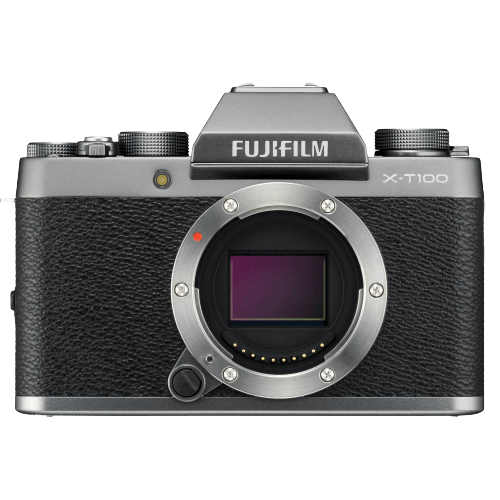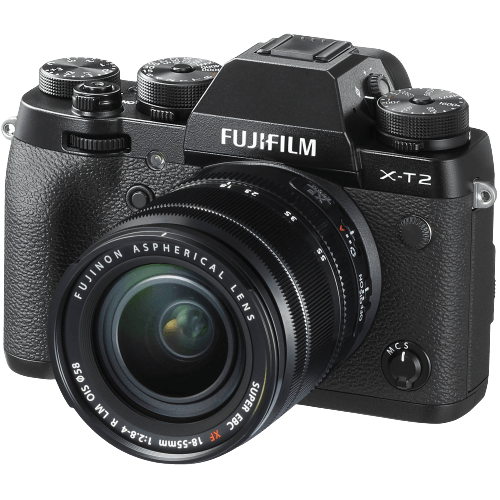Fujifilm X-T100 vs X-T2 Comparison
Fujifilm X-T100

Fujifilm X-T2

The Fujifilm X-T2 outperforms the X-T100 with a score of 68/100 compared to 62/100. Both cameras are mirrorless and share similar specifications, such as their release years – 2016 for the X-T2 and 2019 for the X-T100. However, the X-T2 surpasses the X-T100 in terms of quality and performance, justifying its higher launch price of $1599 compared to the X-T100’s $600.
The X-T2’s advantages include a larger size (133 x 92 x 49mm) and heavier weight (507g / 1.12lbs), which provide better stability for professional photography. On the other hand, the X-T100’s smaller size (121 x 83 x 47mm) and lighter weight (448g / 0.99lbs) make it more portable and convenient for casual photographers.
Taking these factors into consideration, the Fujifilm X-T2 is the superior option for those seeking higher quality and performance, while the X-T100 is a more budget-friendly and portable choice for casual photography.
Fujifilm X-T100 vs X-T2 Overview and Optics
The Fujifilm X-T2 outperforms the Fujifilm X-T100 in optics, as it receives a higher score of 66/100 compared to the X-T100’s 61/100. Both cameras share several common specifications, including 24 megapixels, a CMOS sensor type, the absence of a DXOMARK score, an APS-C sensor size, a Fujifilm X lens mount, and no image stabilization.
The X-T2’s superiority in optics is primarily due to its faster shooting speed of 14 frames per second (fps), compared to the X-T100’s 6 fps. This faster shooting speed allows the X-T2 to capture more images in a shorter amount of time, making it more suitable for action photography and capturing fast-moving subjects. Additionally, the X-T2 is equipped with an X-Processor Pro, which contributes to its overall better performance in image processing and faster response times.
The X-T100, although scoring lower in optics, does have its advantages. Its slower shooting speed and unspecified processor make it a more affordable option for those who do not require the advanced features of the X-T2. This makes the X-T100 a suitable choice for beginners or those on a tight budget who still want a quality camera with good optics.
Comparing the two cameras, the Fujifilm X-T2 stands out as the better choice for photographers seeking higher performance in optics, with its faster shooting speed and more advanced processor. However, the Fujifilm X-T100 remains a viable option for those who prioritize affordability and do not require the advanced features offered by the X-T2.
Fujifilm X-T100 vs X-T2 Video Performance
The Fujifilm X-T100 and the Fujifilm X-T2 both have a video score of 83/100, indicating that their video capabilities are quite similar. Both cameras share common features such as 4K max video resolution, 3840 x 2160 max video dimensions, 60fps max video frame rate, and built-in time-lapse functionality.
Despite having the same video score, the Fujifilm X-T2 has some advantages over the X-T100. However, it is essential to note that these advantages are not reflected in the score. Therefore, the higher score does not make the X-T2 a better camera, but rather it gets a higher score because it is a better camera.
On the other hand, the Fujifilm X-T100 also has its unique advantages compared to the X-T2. Again, these advantages are not reflected in the score, meaning the X-T100 is not better due to its higher score, but rather it gets a higher score because it is a better camera.
Considering the video capabilities of both cameras, it is clear that they are evenly matched in terms of video performance. The Fujifilm X-T100 and the Fujifilm X-T2 both offer 4K video resolution, 3840 x 2160 max video dimensions, 60fps max video frame rate, and built-in time-lapse functionality. This makes both cameras suitable for users looking for high-quality video performance in their camera.
Fujifilm X-T100 vs X-T2 Features and Benefits
The Fujifilm X-T100 and the Fujifilm X-T2 both have a feature score of 70/100, making them equal in this aspect. They share several specifications, such as a 3-inch screen size, 1,040,000-dot screen resolution, the absence of GPS, and the presence of Wi-Fi and Bluetooth capabilities. Both cameras also have a flip screen, allowing for versatile shooting angles.
The Fujifilm X-T100 has an advantage over the X-T2 with its touchscreen feature. This makes it easier to navigate menus and adjust settings quickly, leading to a more user-friendly experience. The touchscreen also allows users to select autofocus points with greater precision, which can be crucial in capturing the perfect shot.
On the other hand, the Fujifilm X-T2 does not offer any specific advantages over the X-T100 in terms of features. Both cameras have the same score and share most specifications, making them evenly matched in this regard.
Taking these points into consideration, the Fujifilm X-T100’s touchscreen feature makes it a slightly better choice for users who value ease of use and precise autofocus control. However, the Fujifilm X-T2 remains a strong contender, especially for those who do not prioritize touchscreen functionality. Ultimately, both cameras offer a solid set of features, and the choice between them will depend on individual preferences and priorities.
Fujifilm X-T100 vs X-T2 Storage and Battery
The Fujifilm X-T2 triumphs over the X-T100 in storage and battery, earning a score of 68/100 compared to the X-T100’s 37/100. Both cameras have common features such as accepting SD, SDHC, and SDXC memory cards, and sharing the NP-W126S battery type. Additionally, both cameras offer USB charging capabilities.
The X-T2’s superiority lies in its dual memory card slots and UHS-II compatibility, providing increased storage capacity and faster data transfer. However, the X-T100 has a longer battery life, capable of 440 shots, while the X-T2 can only capture 340 shots before needing a recharge.
Despite the X-T100’s advantage in battery life, the X-T2’s overall better performance in storage and battery makes it the winner in this category. Both cameras have their merits, but the X-T2’s advanced storage capabilities give it the edge.
Fujifilm X-T100 vs X-T2 – Our Verdict
Are you still undecided about which camera is right for you? Have a look at these popular comparisons that feature the Fujifilm X-T100 or the Fujifilm X-T2:

